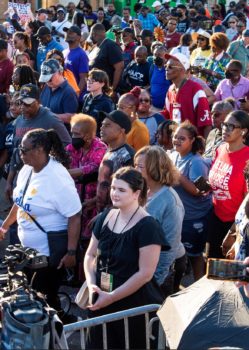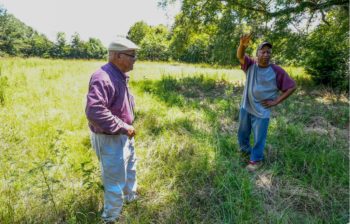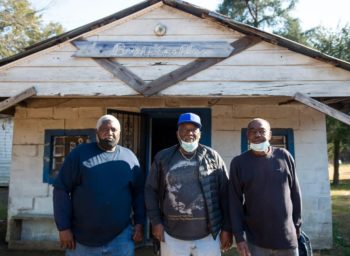How the Montgomery Advertiser is building trust and growing audiences in Alabama’s rural communities
Paige Oliver Windsor and Hadley Hitson, Montgomery Advertiser,
Montgomery Advertiser reporter Hadley Hitson interviews Equal Justice Initiative executive director Bryan Stevenson at the EJI offices in Montgomery, Ala. (Mickey Welsh/Montgomery Advertiser)
Here’s an idea to steal and adapt: Build trusted relationships with people who have lived without local news sources for years, by showing up for these communities, listening to them and delivering the content they most want. Make sure the coverage is for these communities, not simply about them.This is a series on Better News to a) showcase innovative/experimental ideas that emerge from the Knight-Lenfest Newsroom Initiative and b) share replicable tactics that benefit the news industry as a whole. This “win” comes from Paige Oliver Windsor, Gulf Coast editor for the USA Today Network and executive editor of the Montgomery Advertiser, and Hadley Hitson, Rural South reporter at the Montgomery Advertiser, which participated in the UNC-Knight Foundation Table Stakes program in 2021-22.
Question: What communities do you serve and what can you tell us about the history of your organization?
Answer: The Montgomery Advertiser covers Alabama’s capital and surrounding areas that make up the River Region of central Alabama. The newspaper was first published in 1829, taking the Montgomery Advertiser name in 1833. Its main local competitor was the Alabama Journal, founded in 1889, but that publication ultimately ceased publication in 1993 and merged with the Advertiser. Multimedia Corp. purchased the publication in 1968; Gannett bought it in 1995.

Montgomery Advertiser reporter Hadley Hitson covered the march across the Edmund Pettus Bridge in Selma, Ala., on the 58th anniversary of Bloody Sunday. (Mickey Welsh/Advertiser)
Historically, the paper promoted slavery and slaveholder rights, publishing fugitive slave ads that encouraged bounty hunters and gave tacit approval to violence. The Advertiser’s editorial board opposed secession, but it embraced white supremacy in the years after the Civil War. Within its news coverage, the Advertiser’s biases and ambivalence contributed to decades of terror against Black Alabamians. Indeed, the Equal Justice Initiative deemed the publication “complicit” in the horrors of slavery, Jim Crow laws and lynchings.
Today, the Advertiser is a general interest publication and digital platform with heavy emphasis on capital city politics and Statehouse coverage, as well as SEC sports, which include both Auburn University and University of Alabama.
Still, the publication’s past with some parts of the community remains complicated, if unforgiven. In recent decades, the newsroom has emphasized more inclusive coverage of the community, provoking a smattering of racist letters and canceled subscriptions. Even Montgomery’s city seal seems to acknowledge the ongoing dichotomy, carrying two mottos: “Cradle of the Confederacy,” and “Birthplace of the Civil Rights Movement.”
Q: What problem were you trying to solve, and why was solving the problem strategically important for your organization?
A: In our bid to find new avenues for revenue, including subscriptions, our strategy is to be an enterprise-focused operation that drives subscriptions by prioritizing audiences that are most hungry for our content.
That audience was all around us in the rural communities of Alabama.
Hadley Hitson, a Report for America corps member, was already in place to cover the Black Belt, a primarily rural geographic area in the Southern United States, so named for its fertile soil that proved ideal for growing cotton. Hitson was innately doing what we learned we would need to do more of: building trusted relationships with people who had lived in news deserts for years, by showing up for these communities.
Reaching them required that we build trust in those communities and deliver the content they most wanted.

Lowndes County, Ala., resident Perman Hardy shows where sewage was once dumped behind her and her neighbors homes. (Jake Crandall/Advertiser)
From the earliest days, we said the coverage was for the Black Belt communities, not about them. And that’s gone a long way with these readers and potential readers. We also determined early on that there were two kinds of audiences for us in this work: those for whom we would create content to seek subscriptions, and those for whom we would create content so indispensable that it would be worthy of grant funding.
Our rural, news-desert coverage successfully grew subscriptions in their counties, but our primary goal was to serve this audience and sustain our reporting efforts with ongoing grant funding.
Q: How is this approach related to Table Stakes (e.g. one of the 7 Table Stakes and/or an outgrowth of the Knight-Lenfest initiative, etc.)?
A: This initiative relates to Table Stake No. 1 (“Serve targeted audiences with targeted content,”) and Table Stake No. 2 (“Publish on platforms used by your targeted audiences.”)
Specifically, when we started working with Table Stakes, it was a few months into building out the Rural South beat at the Advertiser. We had just begun to develop a strategy for covering 18 of Alabama’s most rural and high-poverty counties. The only way that we were going to succeed in such a vast coverage area was to put our audience first. That is a key tenet of Table Stakes.
We also quickly realized that our audience wasn’t going to find us on their own.
We had to go to them, both figuratively and literally. It took a lot of driving and a lot of meetings with community leaders to develop trust among the people who could advocate for the Advertiser’s coverage.
We also tested out plenty of means of virtually delivering our content to these communities: creating a group on Facebook, asking community members to share relevant articles, and communicating one-on-one via email with the rural readers who didn’t know how else to reach us.
Q: How did you go about humanizing the issues facing rural Alabamians?
A: The basic answer is putting people’s stories first.
If we were going to make readers across the South see rural Alabamians as anything other than the stereotype in their minds, we had to show them the complex stories of real people. And if we wanted those rural Alabamians to read our news and accept our coverage, we had to show them that they would not be reduced to their worst parts. After all, we didn’t want them to reduce us to our worst parts, either.
One example is the wastewater crisis in Lowndes County. Hundreds of homes there don’t have access to adequate sewage disposal systems, and residents are used to seeing politicians and reporters trek through their communities with sad looks on their faces.
After just a few honest conversations, we realized that the pity wasn’t the story. The residents of Lowndes County were tired of that narrative. Instead, we reported on two women at the forefront of raising money and installing sewage systems that worked, one by one. The story was progress.
We also delivered stories that underscored systemic barriers to equity in these areas, covering topics such as heir property, a primary cause of land loss among Black families and a major factor contributing to poverty in the Black Belt.

Lorenzo Tolbert (left) and his brother Barry Harrell stand on their family property, which others have attempted to sell without their permission, near Marion Junction, Ala. The brothers face a common issue in the Black Belt: heir property. (Mickey Welsh/Advertiser)
Our coverage has also celebrated the area’s arts and culture. In one story, Hitson showcased the enduring creations of Gee’s Bend, where women began quilting “out of necessity while enslaved on a nearby cotton plantation in the 1800s. The tradition carried on, and during the civil rights movement, it evolved into a means for economic empowerment as they sold the quilts to the masses,” she writes. That work, Hitson reported recently, has gained greater prominence in recent years.
We are seeking funding to continue this work when Hitson’s two-year Report for America term ends in June. We have been talking with potential angel investors in the local business community and are seeking new partnerships with nonprofits.
Q: What source development tactics did you apply to broaden your connections in the communities you serve?
A: In rural communities, there is always going to be at least one leader who knows everyone, and whom most everyone trusts. Finding those people and getting them on our side was crucial to our rural coverage.
Many people in these small, news desert towns have an understandable mistrust of — and even hatred for — the media. Their problems and struggles have either been ignored entirely or publicized as their only defining factor.
So, when you show up, it’s important to understand that their judgment is not about you; having someone to vouch for you makes it so much easier to connect with a community.
We also made sure to share information about ourselves, our jobs and why we wanted to talk to them or get to know people in their town.
Q: Where do you go to find information about your community and whom do you talk to?
A: The ways we found those community leaders were varied, but in rural Alabama, churches and nonprofits were a good place to start. Typically, they either are the right people to be talking to or they’re nice enough to point you in the right direction.

Bill Gibbs (center) poses alongside his neighbors outside the community center in Uniontown, Ala. Gibbs is among the residents who worry about the impact the massive Arrowhead Landfill is having on their community. (Jake Crandall/Advertiser)
If we were going into a community without an idea for a story or any sources yet, we would also just ask to chat about problems or successes we had heard about in similar communities. Especially in rural news deserts, the people you speak with are always going to know what’s interesting about their community, but they’re rarely going to think it’s newsworthy.
Part of source development in rural areas can be reminding people that their lives and their town matter to people beyond their community.
Q: How do you strategically apply beat mapping to your content and audience outreach?
A: The strategy of prioritizing our content decisions for the readers who are most hungry for it is built into the beat-mapping process itself.
It begins with a visualization exercise (what the beat is / what the beat isn’t) to better understand how the reporter perceives the beat’s scope and coverage approaches.
From there we discuss the target audience(s) for this coverage and what they specifically need and want from us. Then comes the science: matching these perceptions and the reporter’s gut instincts to the actual content performance data. It gives the reporter and editor a chance to recast their coverage strategy if it isn’t working, and gives them permission to stop doing what doesn’t resonate with our target audiences.
For example, when it came to rural beat mapping, we realized that a lot of rural areas experience the same problems, but they don’t want our newspaper telling them that.
Instead of taking general approaches to issues (i.e. “Rural ambulance services at risk as funds stretch thin in the Black Belt”), we began to highlight a specific community experiencing the problem or a certain group working to solve it (i.e. “Tuskegee resident tells story of ‘torn life’ as an Indian immigrant in rural Alabama”).
While one story centers around a general problem that impacts several rural towns, the other tells a specific person’s story, touching on a variety of issues that rural residents face. The first story received 680 pageviews in its first month of publication while the second received 5,370. This trend showed up across topics.
We realized our readers want hyper-specific stories with actual people at the forefront if they’re going to read anything out of rural Alabama.
The other difference between the two stories is the paywall. In the three months between publication, we made the decision to publish all rural Black Belt stories as metered content instead of behind a subscriber-only paywall. Once we did that, articles on the beat were getting read more, and subscriber numbers in our eight targeted rural counties increased — one by 200%.
Q: What have you learned about connecting with audiences who are in news deserts or don’t historically have good relationships with local news outlets?
A: We hired Hitson, who is white, knowing that the paper’s problematic handling of race in decades past could make it difficult for her to break through in these largely Black communities. How she would approach that was a focal point of the interview.
She knew it would be a mistake to parachute in and expect people would open up to us. To build trust, she said, we had to show up, and show up again. That’s how we build trust in any community.
The bigger hurdle, we soon learned, was a general distrust of media among Black Belt communities. Extra close-knit communities were wary of letting in outsiders. In some cases, older men were not willing to trust a young woman with their stories.
About three months into building out the beat. Hitson had covered a few stories in nearby Lowndes County and felt as though community members were starting to believe in her work. But when news came along that people didn’t want to talk about — the Department of Justice opening a civil rights investigation in the county — she struggled to find residents who would speak with her.
Her follow-up story ended up focusing on the legal route rather than the residents, and she didn’t give up. She continued to attend every community meeting on the topic. Now, when Hitson is writing a story in the county, she knows a core group of community leaders whom she can rely on to point her in the right direction.
Q: What advice would you give to others who try to emulate your success?
A: Take the time to understand the audience you’re targeting. Understand not just what’s important to them, but how they want to communicate with you.
The digital advisory group we created on Facebook has worked wonders in some other USA TODAY Network newsrooms, but for the rural Alabama audience, email often proved a more comfortable medium. That left Hitson managing a lot of one-off communications. But since this was what the audience preferred, Hitson dedicated herself to wrangling 1:1 correspondence to share stories and engage in conversation, in addition to managing the digital advisory group on Facebook.
Be open to changing your perception of what constitutes success, as well. Providing relevant coverage to rural audiences isn’t a huge moneymaker, but it’s an essential service that we can offer if we can secure independent funding such as grants.
Q: Is there anything else you’d like to add?
A: Another key aspect of building out our rural coverage was patience. Even when we could see our vision clearly — the kinds of deep stories we wanted to tell and the mutual respect we wanted to have across the Black Belt — we couldn’t just will it into existence.
We had to trust in our trial-and-error method, building our rural audience one by one.